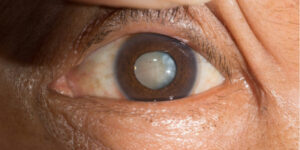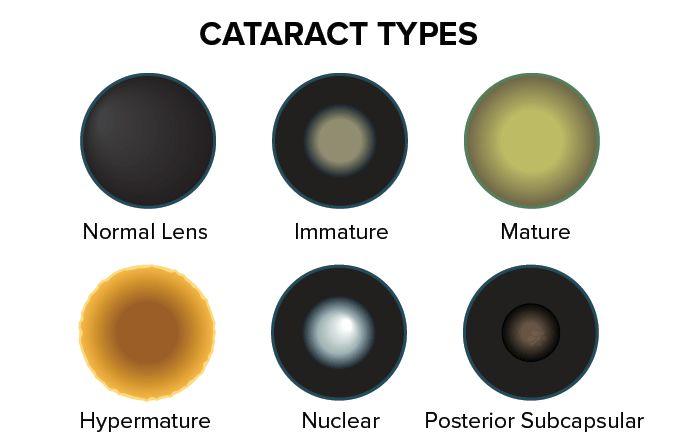If you have been told by your eye doctor that you have a cataract, it is important to learn about the different types of cataracts. Not all cataracts are created equal, and there are different ways to treat them. In this blog post, we will discuss the different types of cataracts and what you need to know about them.
Contents
What Are Cataracts?
 Cataracts are a clouding of the eye’s natural lens, caused by age-related changes or injury. It is the most common cause of vision loss in older adults and can lead to blindness if left untreated. This condition is easily treatable, however, and the only way to prevent further vision loss is through early diagnosis and treatment.
Cataracts are a clouding of the eye’s natural lens, caused by age-related changes or injury. It is the most common cause of vision loss in older adults and can lead to blindness if left untreated. This condition is easily treatable, however, and the only way to prevent further vision loss is through early diagnosis and treatment.
It is estimated that cataracts are the cause of vision loss in more than half of all cases worldwide. There are several types of cataracts that can affect different parts of the eye. Let’s further discuss the different types of cataracts and what you should know about them.
Different Types Of Cataracts
There are various types of cataracts, which vary depending on the cause and location of the clouding. Most cataracts fall into three main categories – age-related, secondary, or congenital cataracts.
Age-Related Cataracts
Age-related cataracts are the most common form of cataract and usually develop with age due to changes in the lens of the eye. These cataracts can be divided into two main types, nuclear and cortical.
- Nuclear cataracts are usually centrally located and affect the nucleus or center of the lens. Nuclear cataracts typically develop slowly over time and progress in density, eventually leading to vision impairment.
- Cortical cataracts form on the edges of the lens, in a spoke-like pattern. They are caused by changes to the proteins in the lens and are usually identified as white, wedge-shaped opacities.
These are believed to form due to the accumulation of calcium and other minerals, leading to a breakdown of the lens fibers.
Secondary Cataracts
Secondary cataracts are caused by another eye condition or disease such as:
- Diabetes
- Injury
- Radiation therapy
- Steroid use
- Certain medications
These types of cataracts generally form quickly and progress rapidly compared to age-related cataracts. This type of cataract can also form at any age and can lead to more severe vision impairment than age-related cataracts. Some of the types of cataracts caused by these factors include subcapsular, total, and polar cataracts.
Subcapsular is a type of cataract that develops at the back of the lens. People with diabetes are more likely to develop this type. Total cataracts involve the entire lens and usually result from trauma or radiation. Polar cataracts involve the outer portion of each lens and often develop in people over 60.
Congenital Cataracts
 Congenital cataracts are cataracts that are present at birth or form shortly after. They can be caused by genetic factors, environmental exposures in utero, or infections such as rubella and toxoplasmosis.
Congenital cataracts are cataracts that are present at birth or form shortly after. They can be caused by genetic factors, environmental exposures in utero, or infections such as rubella and toxoplasmosis.
Rubella is a virus that can pass from mother to child during pregnancy and cause developmental defects as well as cataracts. Toxoplasmosis is a parasitic infection caused by the protozoa Toxoplasma gondii. This condition can be passed on to a fetus and lead to vision problems, including congenital cataracts.
Overall, these are some of the different types of cataracts and what you need to know about them. If you are experiencing any vision changes, be sure to visit your eye doctor for an examination. Early detection and treatment can help prevent or reduce the severity of vision loss due to cataracts. With proper management, you can avoid more serious complications associated with cataracts and enjoy improved vision.
What Are Some Common Signs And Symptoms?
There are many signs and symptoms associated with different types of cataracts. Some common ones may include:
- Difficulty seeing at night or in low light
- Blurred vision (especially when looking at shapes or colors)
- Seeing halos around lights
- Sensitivity to glare and bright light
- Fading or yellowing of colors
- Double vision in one eye
- Frequent changes in eyeglass or contact lens prescription
- Needing brighter lighting for reading and other activities
It is important to identify the common symptoms of the different types of cataracts as early diagnosis and treatment are recommended. If you are experiencing any of these symptoms, it is best to consult with an eye doctor as soon as possible.
They can do an accurate diagnosis and develop a treatment plan that’s tailored to your individual needs. A proper diagnosis may also help prevent further vision loss. In fact, cataracts can often be treated with different types of treatment.
How Can You Manage It?
Cataracts can be managed with a variety of treatment options. Your doctor will determine the best option for you based on your eye condition. Treatment options generally involve surgery, medication, or lifestyle changes.
Surgery is usually the most effective option to remove cataracts and restore vision. During this procedure, an ophthalmologist (eye doctor) will remove the cloudy lens and replace it with an artificial intraocular lens.
Medication is another option to deal with cataracts. Eye drops, such as anti-inflammatory or anti-glaucoma medications, may be prescribed to reduce inflammation of the eye and improve vision. In some cases, steroid injections may be used to reduce the size of a cataract.
Making lifestyle changes can help manage your condition as well. Eating a healthy diet, exercising regularly, wearing sunglasses to protect your eyes from UV rays, and reducing eye strain are all important steps for managing cataracts. Additionally, regular check-ups with an ophthalmologist can help to monitor your condition and ensure that you receive the best treatment available.
Cataracts don’t have to keep you from living a full and happy life. With careful management, you can maintain good vision and live a healthy, active lifestyle. Speak with your eye doctor today to determine the best course of action for your particular situation.
Conclusion
The bottom line is that cataracts can affect everyone, regardless of age. While most people associate cataracts with old age, they can develop at any time in life and should be treated promptly to prevent vision loss. Knowing the different types of cataracts and understanding their causes, symptoms, and treatment options is key to managing this condition.
If you are experiencing any of the signs and symptoms of a cataract, speak to your doctor immediately. Early treatment can help you preserve your vision. With the right care, most people can maintain good vision for many years after a cataract diagnosis.
For more information and guidance, be sure to contact Mantra Care. At MantraCare we have a team of experienced eye surgeons, who will be happy to answer any questions on cataract surgery. Call us at +91-9711116605 for any inquiries.
